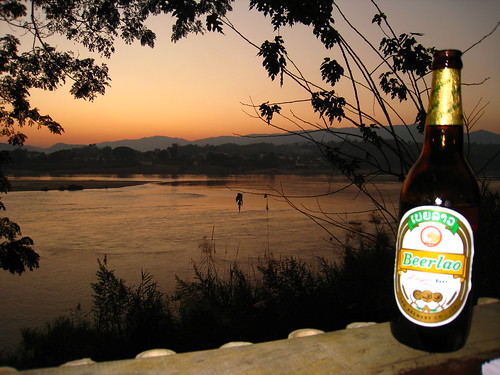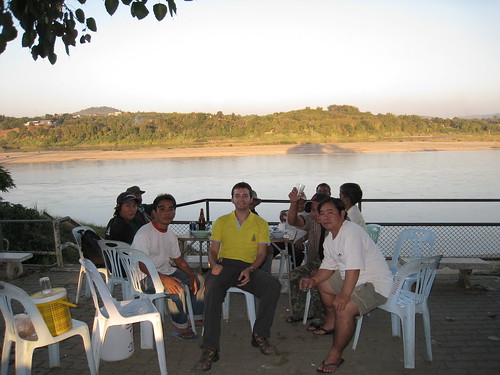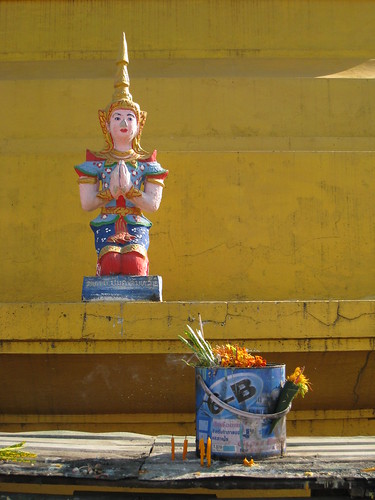
The Mekong river is the border between Thailand and Laos in the north and then again for the central and southern regions. Chiang Klong and Huay Xia sit opposite one another across the northern border. They exist in a relaxed stupor with some beautiful scenery surrounding them. They do not have the hustle and bustle of commercial border towns (such as Mae Sai). While most people pass through and only stay if they have to, they both make a nice relaxed place to watch the Mekong flow by.
Thailand and Laos are similar in many ways. Ethnically Thai and Lao are very similar. Today more ethnic Lao live in Bangkok then Vientaine (the capital of Laos), due to internal migration from Isan. The languages are very similar. Lao is a newer language than Thai but it is based on an older alphabet. When Laos decided to formalise the language they used an alphabet devised by the Thais (which in turn had been created by Khmer scholars who used Mon scripts as models). Understandably there are a great number of similarities between the languages. The lowland Laos generally understand Thai. The number system is almost identical and as a foreigner the only new number you really need to learn is for a thousand (other than eight or twenty). The need for a thousand is because the smallest denomination in Kip (Lao currency) is 1,000. There is a 500 Kip note but most tourists haven't seen one and it is pretty difficult to buy anything for 500 Kip. The exchange rate is roughly 10,000 Kip to 1 US Dollar. The romanization of the Lao language suffers from a similar problem to that of Thailand in that there isn't a standard romanization. The romanization of the Lao language is generally how the French would pronounce it rather than the English. The clearest example of this is with the name of the capital Vientiane. The correct English pronunciation is Wieng Chan. However, if you say this to fellow travellers they do not know where you are referring to.
Unsurprisingly Thailand and Lao, being bordering nations, have a history that is woven together . Laos was originally the bigger player. The Kingdom of Lan Xang, Land of a Million Elephants (the equivalent today would be the Land of a Million Tanks) established by Fa Ngum in 1353 originally held sway. However, ever since the invasion of 1778 Laos has very much been the junior partner to Thailand (Siam). Thailand's most revered Buddhist artifact is the emerald Buddha, which was taken from Vientiane during the invasion of 1778. In 1827 the Siamese burnt Vientiane to the ground and deported most of the population to Siamese lands. The Vietnamese also pressured Laos, with the province of Xiang Khoang being a Vietnamese protectorate since the 15th century. If it wasn't for the intervention of the French and the protection that they offered it is conceivable that Lao would have ceased to exist. In 1893 the French pressured the Siamese into accepting a French protectorate east of the Mekong. However, this confined the vast majority of the Lao population to be left in Siam, the region of Isan north-eastern Thailand. Laos only has a population of 6 million people, with the Isan people it would be close to 20 million. In 1987 Thailand and Laos relations descended into conflict over a border dispute, 1,000 people died before a cease-fire was called in 1988.
 Chiang Klong is the crossing point to Huay Xai in Laos. Chiang Klong is so relaxed it is almost horizontal. The locals are particularly friendly, even by Thai standards. I went looking for the Giant Catfish Museum. This part of the Mekong is famed for them. I stumbled upon a group of local fisherman who invited me to join them. They were drinking rice whiskey and by their general mood had got through a fair amount already. A few spoke some broken English and my phrasebook was used in reverse to ask me questions. They enquired about my I Love the King t-shirt and whether it was because I liked yellow, when I said it was for the King they were extremely pleased. They found my attempts at pronouncing their names hilarious. One of them wanted his photo taken with me and they were very pleased to have a group shot. I was invited to join them the next day, to which I politely declined as I was going to Laos. If you are in Chiang Klong in the afternoon pop down to the Giant Catfish Museum and I am sure they will be there.
Chiang Klong is the crossing point to Huay Xai in Laos. Chiang Klong is so relaxed it is almost horizontal. The locals are particularly friendly, even by Thai standards. I went looking for the Giant Catfish Museum. This part of the Mekong is famed for them. I stumbled upon a group of local fisherman who invited me to join them. They were drinking rice whiskey and by their general mood had got through a fair amount already. A few spoke some broken English and my phrasebook was used in reverse to ask me questions. They enquired about my I Love the King t-shirt and whether it was because I liked yellow, when I said it was for the King they were extremely pleased. They found my attempts at pronouncing their names hilarious. One of them wanted his photo taken with me and they were very pleased to have a group shot. I was invited to join them the next day, to which I politely declined as I was going to Laos. If you are in Chiang Klong in the afternoon pop down to the Giant Catfish Museum and I am sure they will be there. Huay Xai is smaller and a touch down trodden compared to Chiang Klong. I wandered up the boat ramp into the town and I kept getting hassled by one particular sangthaew driver. I sat down in a cafe at BOP Guesthouse for a drink only to discover that this guy owned it. He continued hassling me and then offered his sister to me in marriage. There seemed to be a lot of travellers staying there, but I wasn't impressed by Huay Xai's version of Del Boy. I stayed at Oudomphone Guesthouse. It was 250B for a double ensuite with hot shower. Much like Chiang Klong there are alot of guesthouses and hotels to choose from.
Huay Xai is smaller and a touch down trodden compared to Chiang Klong. I wandered up the boat ramp into the town and I kept getting hassled by one particular sangthaew driver. I sat down in a cafe at BOP Guesthouse for a drink only to discover that this guy owned it. He continued hassling me and then offered his sister to me in marriage. There seemed to be a lot of travellers staying there, but I wasn't impressed by Huay Xai's version of Del Boy. I stayed at Oudomphone Guesthouse. It was 250B for a double ensuite with hot shower. Much like Chiang Klong there are alot of guesthouses and hotels to choose from. I caught the 3rd class bus to Chiang Klong from Chang Rai (57B) taking 4 hours. The bus stops on the outskirts of town and it costs 20B for a motorcyle taxi or a 10 minute walk into the town centre. There are lots of guesthouses to choose from. They line the road through town, that parallels the Mekong. I settled for Baan Tamila, about halfway through town. The room (a twin) was 350B, with ensuite hot shower and a view of the Mekong. The restaurant had an even better view.
The border crossing is exceptionally straightforward. On the Thai side follow the road through Chiang Klong to the end, walk down the slope towards the Mekong and get your passport stamped at Thai immigration. The longboats to cross the Mekong are at the bottom of the ramp. There is a tent with a desk where you pay 30B to cross to Huay Xai. The journey takes less than 5 minutes. On my boat were a large group of people doing the slow boat from Huay Xai to Luang Prabang. I was surprised at the number of people doing it considering the bad reports I had heard about the journey. When I reached Luang Prabang I met lots of people who had done it and their opinions o the journey ranged from indifference to annoyance about the journey. On the Huay Xai side you walk up the ramp and then up a flight of stairs to Laos immigration. You can get your visa here. I got mine in Bangkok at the Laos embassy. I didn't realise at the time but because the Laos government now gives 30 day visas at the Huay Xai border crossing they now give visitors 60 days if you already have your visa.
No comments:
Post a Comment